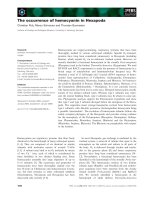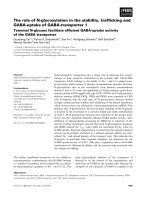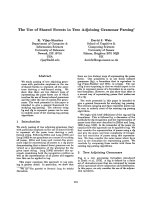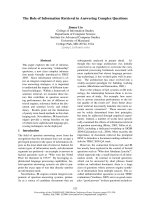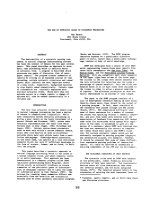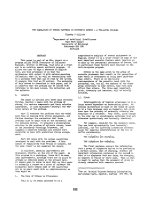Báo cáo khoa học: "THE SIMULATION OF STRESS PATTERNS IN SYNTHETIC SPEECH" ppt
Bạn đang xem bản rút gọn của tài liệu. Xem và tải ngay bản đầy đủ của tài liệu tại đây (647.77 KB, 7 trang )
THE SIMULATION OF STRESS PATTERNS IN SYNTHETIC SPEECH ~ A
T,VO-LEVEL
PROBLEM
Timothy J Gillott
~partment of Artificial Intelligence
Hope Park Square
University of Edinburgh
Edinburgh EH9 2NH
Scotland
ABSTRACT
This paper is part of an MSc. report on a
program called GENIE (Generator of Inflected
English), written in CProlog, that acts as a front
end to an existing speech synthesis program. It
allows the user to type a sentence in English
text, and then processes it so that the
synthesiser will output it with natural-sounding
inflection; that is, as well as transcribing text
to a phonemic form that can be read by the system,
it assigns this text an fO contour. The assigning
of this stress is described in this paper, and it
is asserted that the problem can be solved with
reference to two main levels, the sentential and
the syllabic.
O. ~enePal
The paper is divided into three main sectiona
Firstly, Section 1 deals with the problem of
stress, its various components and their relative
~,portance. It also discusses (briefS) the two-
level nature of the problem.
Part II examines the problems that the model
must face in dealing with stress assignment, and
further develops the contention that these
problems must be dealt with at the sentential and
the syllabic levels. It proposes a phonological
solution to the problem of syllabic stress, based
on the Dependency Phonology framework, and
suggests a modified function and content word
algorithm to deal with sentential stress assign-
ment.
Part III deals with the actual algorithms
developed to deal with the problems. A fair
~nount of familiarity with Prolog is ass~ned, but
the code itself is not examined too deeply.
In addition, possible improvements are
discussed, briefly, at the end of the paper. As
this program is a prototype, there will be many
such improvements, although there are no plans to
produce an enhanced model at the present date.
It should also be borne in mind that as this paper
is primarily a report on a piece of software the
linguistic bases behind some of the algorithms
are by no means dealt with as comprehensively as
they might be.
1. The Role of Stress in Utterances
This i~ ~- nemeans intended to be a
comprehensive analysis of stress assignment in
English, rather it is a brief review of some of the
most important acoustic factors which together go
to make up the perceptual phenomenon of stress, and
in particular those factors most relevant to the
text-to-speech program.
Stress is the name given to the group of
acoustic phenomena that result in the perception of
some words in utterances as being more important
than others. There is no one-to-one
correspondence of the acoustic level with the
perceptual one, but all the members of the above
group contribute to some extent, some with more
effect than others. The three most important,
pitch, intensity and duration, will be briefly
reviewdd.
1.1 Pitch
Intelligibility of English utterances is to a
large extent dependent on contrasting pitch. No
lexical distinction is made on the basis of pizch
as in a tone language such as ~andarin, but pitch
does have the property of radically altering the
semantics of a sentence. Ver-j often, pitch change
is the only way to disambiguate sentences that are
otherwise syntacticaly and lexically identical.
For example, consider the two examples below.
They are both syntactically (and lexically)
identical, but the differing intonation oatterns
cause the semantic interpretation of the" two to
differ considerably :
The elephants
charg'[ng.
Th& eleph'ants are " '
charglng.
The first sentence conveys the information
that a group of elephants happen to be perforlaing
a certain action, that of charging, whereas the
important information contained in the secon~ is
that it is elephants that are doing the charging,
as opposed to rhinos or white mice. This is what
is meant by saying that the movement of pitch is
closely connected with semantic conzent.
"lNow
at: British Telecom Research Laboratories,
Martlesham Heath,-Ipswich, Suffolk IP5 7RE, UK
232
An important point arises here; this is that
although the meaning of the whole sentence is
changed by the different intonation pattern, the
actual words themselves retain the same meaning in
both examples. That is, there are ~o levels of
semantic information contained within a sentence;
morphological (word level) and sentential
(utterance level). This distinction is important
and runs through the whole problem of synthetic
stress assignment, and will be considered in more
detail later in the paper.
Although sentential stress often varies,
morphological stress does so much less frequently.
For instance, the stressed syllable is the first
one in the word "elephant". To put it on the
second syllable would destroy the semantic message
conveyed by the word "elephant". When
morphological stress does differ within the same
word, it invariably accompanies a radical differ-
ence in the semantics of a verb, and is usually
syntactically defined; viz project (the noun) as
opposed to project (the verb).
It is obvious to say that pitch varies to
indicate stress within both words and utterances.
~uthow does it vat-j? It would be tempting to say
that a stressed syllable is always signalled by a
rise in pitch, as in the examples above. This is
indeed true in a great number of cases, but by no
means all, as pointed out by Bolinger (Bolinger
1958). For instance, consider the following phrase
(taken to mean "do continue"):
Go on.
Clearly in this common utterance, it is the
"on" that is emphasised, and it can easily be seen
that pitch is lower for this word. Bolinger
determined that pitch movement, rather than pitch
rise only, is the important factor and that the
point in the sentence where intonation is
perceived to rise or fall serves as an important
indicator of stress.
1.2 Intensity
The subjective impression often gained from a
stressed word in an utterance is that it is somehow
"louder" than the non-stressed words. If this were
so, it would be reasonable to assume that there
would be some physical evidence for this in terms
of effort made by the speaker, and in terms of
measurable intensity. Until fairly recently, no
method existed to prove satisfactorily that effort
increased when a word was stressed, but experiments
by Ladefoged (Ladefoged 1967) to obtain myographs
of intercostal muscle movement have revealed a
heightened tension in these muscles when articulat-
ing stressed syllables. The same set of
experiments also revealed a small increase in
subglottal pressure when a speaker emphasised a
syllable. So physiological evidence does point to
increased effort expelling the airstream when
stressed syllables are produced. This should ~ve
some correlate in measured intensity.
i. 3 Duration
Duration is recognised as being connected
with the perception of stress, even if people tend
not to recognise it as such. This holds for
synthetic speech as well as for natural speech.
Experiments carried out with an early version of
the stress assignment program indicated that
duration is useful, if not essential, to produce a
natural-sounding stress pattern, particularly
sentence-finally. A sentence with natural fO
movement and durational increase on the stressed
syllables was contrasted with the same sentence
with just fO movement. The result was percept-
ively more natural-sounding with both pitch
movement and durational increase, although it was
perfectly intelligible without the durational
increases. This ties in with observed phenomena
in natural speech and will be discussed below.
1.& Relative Importance of Pitch. Intensity and
Duration
Experiments conducted by Dennis ~ (Fry
1955) indicated that the three contributive
factors discussed above are by no means equally
important in stress perception. A minimal pair
list was taken, and stressed syllables were
presented with two out of the three factors
present, to see what effect this would have on
perception. This is to s~y that the words would
be introduced with pitch movement and durational
increase, but no change in intensity: or intensity
and pitch change would be varied normally, but
duration of all syllables would be kept constant.
The results showed that pitch was by far the most
significant factor in stress perception, followed
by duration. Intensity was relatively unimportant
even to the point of being mistaken for another
parameter (Bolinger, op. tit).
Bolinger found that an increase in intensity
with no corresponding pitch increase was never-
theless heard as a pitch raise. Interestingly
enough, a drop in intensity was not heard as a
drop in pitch, merely as a form of interference,
as if the speaker's words were being carried away
by the wind.
Similar experiments carried out with an early
version of this program indicated that the same
could be observed in synthetic speech. Intonation
clearly had the greatest effect on
intelligibility; duration was seen to be important
but not vital to intelligibility; and intenisty
~as seen to be relatively unimportant.
It was therefore decided to represent stress
in the program as a combination of intonation
movement and durational change. Intensity was not
included because the software that drove the
synthesiser had no facility for user alteration of
this parameter. Taking into account the relative
unimportance of intensity as a cue for stress, it
was not though worthwhile to introduce such a
facility to the driver software.
2. Problems Facing the Model: Types of Stress
It can be seen from the brief outline given
above that GENIE must deal with a complex problem
in assigning stress to utterance. The program
must take the whole utterance, assess it in order
233
to see where stress peaks should occur, and assign
~hem dynamically. A complex phenomenon has to be
represented using very sparse information.
2.1 Types of Stress
Stress assignment is a complex issue at at
least two linguistic levels. As seen in i.I above,
there is a notion of stress both at the syllabic
and the sentential level. Even if the stressed
words were predicted correctly within the sentence
by the program (and this is a far from trivial
problem) there still remains the problem of
correctly predicting the stressed syllable(s)
within the words themselves. Many theories have
been advance, both syntactical (eg Chomsky and
~alle 1968) and metrical (eg Liberman 1979) to
propose a solution to this problem in natural
speech. Whilst acknowledging these hypotheses, a
phonological solution will be proposed which seems
to handle at least as many cases as do the fore-
going. This is the theory that has been implement-
ed in GEi~V.E, and although at present it is in a
prototype stage only, it works well.
This solution takes as its base the
Dependency model of vowel space, and proposes that
it is possible, at least for English and possibly
for other stress languages, to predict syllabic
stress on the position of the syllabic nucleus
within a "sonance hierarchy". This is a central
notion of the Dependency Phonology model (Anderson
1980), and a brief outline of the model follows for
those unfamiliar with it.
2.1.1A Brief Outline of the Dependency Model of
Vowel Space
Various phonological theories have argued for
a non-discrete vowel space, as opposed to a
discrete scale as evidenced in Chomsky and Halle's
system of assigning vowels fixed heights, eg
+low etc. .%nong the models arguing for such a
non~liscrete space is Dependency Phonology
(Anderson, 1980), which takes as its position that
there exists a linear "scale of sonance" from which
continuum points can be chosen. These points are
recognised as vowels. In fact the model goes
further than this in postulating a scale of sonance
for all sounds, as will be seen below.
The notion "scal~of sonance" needs some
clarification. Sonance, or sonority as it is also
knovfn, is best defined acoustically. A highly
sonant sound is characterised by having a high
enerhy content and strong formant banding when
examined on a broad-band spectrogram. These
qualities are those possessed by vowels, and in
fact the model equates sonance with "vowelness",
the degree co which a given sound is like a vowel.
Thus on the "sonance hierarchy", vowels have the
most sonant position, and the continuum goes from
this point via liquids, nasals, voiced fricatives
and voiceless fricatives to voiceless plosives, the
least sonant of all. Thus the points of the scale
are distinguished from each other in that their
acoustic makeup possesses an amount of "vowelness"
that can be compared with that of their neighbours
on the scale. This system is the exact opposite in
concept to the Chomsky and Halle type stepped
scale; it is a stepless scale.
The part of the sonance hierarchy that
interests us most is the more vocalic end.
However, the scrutiny will extend to cover all
sou~da.
2.1.2 Using the Model
This is all very well in theory, but it must
be applied. As was said before, the central idea
is that words can be assigned stress on the basis
of the positions occupied by their component
segments on the sonance hierarchy. Taking vowels
only for a moment, let us see how this works. The
vocalic end of the scale can be seen as shown
below, always bearing in mind that labels such as
"V" or "VSon" are only points along a continuum:
WSon
÷
WC
VSon
Sonance
VC
Thus a word like "proposal" can be seen to
have three syllabic nuclei, one of VC, one of ~D/C,
and one of VC. Following the notion of sonance as
the guiding principle, it can be seen that the
primary stress should be awarded to the diphthong.
And this is indeed true.
But what about words whose syllabic nuclei
both appear to share the same point on the scale,
eg "rabbit", "object"? To attempt to explain this,
the notion of the sonance of individual vowels must
be considered.
Vowels themselves can be ranked on a scale of
sonance. Some vowels are more sonant than others.
Examples of this would be [a9 as opposed to ~i] or
[u]. The theory of Natural Phonology (Donegan and
Stampe) express this concept in terms of colour.
[a] is more sonant and less "coloured", in this
model, than [i2 or [u 3. In Dependency Theo~j, the
difference is expressed in terms of "vowelness" or
sonance. This notion equates to acoustic values,
where [aJ is seen to have more ener~j than Li] or
[u] due to the wider exit shape of the vocal tract
for the former. Experiments carried out by Lehiste
(Lehiste 1970) show that this is also borne out
perceptually. ~Tnen speakers were asked to pro@ice
[a] and [u] at what they considered to be the same
"loudness", the dB reading for ~a ] was in fact
considerably lower than that for [u]. This showed
that ~a] was perceived as being in some way
"louder" and requiring some compensation in order
to pronounce it at the same subjective level as
~u].
Thus it seems reasonable to propose a scale of
sonance for vowels as well as more generally for
all speech sounds. When a word like "rabbit" is
examined, it can be seen that ~aeS wins the stress
assignment as it is much more sonant than [Z7.
Counter examples do exist, and will be briefly
outlined. As it is not the main purpose of this
234
paper to expound a linguistic theory, the outline
will not be as rigorous as it might otherwise have
been. These counter examples divide roughly into
three groups.
(i) Two forms of the same word can have
different stress assignment depending on their
syntactic category. Thus:
Noun object
Verb object
The only explanation that can be advanced for
this in terms of the theory proposed above is that
the two VC groups are close to each other in terms
of sonance. [~ 3and ~Sare both reasonably near
the centre of the tongue height space. Pairs that
exhibit similar behaviour seem to share this
characteristic:
i~UN VERB
I I
project project
It is suggested that only such pairs of words
that have VC groups whose sonance levels are
sufficiently close can exhibit this behaviour, and
even then no explanation can be advanced as to why
this should be so. It seems likely chat the only
explanation is a syntactic one.
(2) Words such as "balance", "valance", etc
present a problem as it is not immediately apparent
as to why the stress should be assigned to the
first VSon group; both the vowels are the same.
However, it should be remembered that nasals
possess less overall energy than do liquids, albeit
not much less. It is suggested that a VNasal group
is marginally less sonant than a VLiquid group.
(3) Words with suffixes also tend to present
a problem, viz:
I I
olastic but plasticity.
It is suggested that the only answer to this
is a syntactic one.
31any words were examined in this way, and
although there was never anything like one hundred
percent correctness, it was seen that such a notion
could form the basis for a robust, compact
algorithm for syllabic stress assignment, ~thout
the need for many production-type rules as seen in
the systems that use MIT-type syntactic stress
assignment rules. It can also be seen from the
above that a syntactic component will probably be
needed to supplement the purely phonological
solution in a developed system. However, it is
submitted that an algorithm based on this system
will be considerably less cumbersome than those
currently used, and should also produce a compact,
natural solution to the problem.
2.2 Sentential Stress
The problem of stress, as stated above, is a
two-level problem. As well as being assigned to
syllables within the word, stress is also assigned
to the whole sentence. The problem is that no one
seems to have produced a definitive set of rules
from which an algorithm for sentential stress
assignment can be evolved. Most text-to-speech
systems use the notion of "function" and "content"
words. While by no means claiming to solve this
problem, an algorithm will be suggested for
sentential stress assignment which works somewhat
better than those in present systems.
3. Algorithms Developed
This selection will explain how GENIE deals
with the two-level problem of stress assignment.
It must be emphasised that the solution proposed is
little more than a prototype, and does not present
a complete solution to this complex problem. The
operation of the Prolog will be examined in
principle, but without going too deeoly into the
code.
3.1 Sentence Processing
Firstly, the user types in a sentence in
normal English text, with word boundaries
ind/cated in the normal way by spaces. Each word
is read in and instantiated to an item in a Prolog
list. Element separations are indicated by commas.
Now the program has to converz the English list
elements to a phonetic transcription. The approach
taken was not to use grapheme-to-phoneme for this
prototype system. Instead, the words were looked
up in a dictionary and the relevant list chansed
element by element. An example will clarify the
stages up to this point:
English text: this is a tricky project.
List form: this,is,a,tricky,project,.
~honetzc form: [dh,qq,i,s,i,z,qq, zz,a,
ch, ci, rr,i,k,k~# ,kz, i,
p,py,pz,rr, o, j, jy, e,k,
k,ky,kz, t, .]
This sentence now has to be classified using
two criteria; firstly the punctuation (giving the
overall sentence type) and the syntactic structure.
The last element in the list is a full stop. This
tells the program that the sentence is a
declarative. If it had had a question mark,
further processing would have been done to
determine what type of question, ie WH-question,
reverse-~ question etc. Nhen this has been done,
the relevant intonation pattern is selected.
Notice that the sentence is not parsed in any
recognised way to determine the type of intonation
pattern. There are merely a series of informal
questions ie "Is sentence a luestion? If it is, is
this question a WH-question?" These informal
checks seem to be all that is necessars'.
3.2 Assignment of Intonation
The two level problem of intonation ~ssignLlent
is dealt with in this program by first assigning an
intonation contour to the sentence, and then
modifying the words that the program selects as
stressed. The following general scheme was
adopted:
235
(i) Assign a general intonation slope to the
sentence.
(2) Fit it to the length of the sentence
(3) Find the stressed word(s) in the sentence
(&) Assign stress peaks to them
(5) interpolate values either side of these
peaks to form a slope
Note that this description is really too vague
to be called an algorithm. Each section contains
algorit~ns, however, and they will be explained in
t drn.
3.2.1 Assignment of General fO Contours
The classification of the sentence was done in
order that the program should select the correct
intonation slope, peak values etc for the type of
sentence typed in. These slopes are simply Prolog
lists of ~nall integers, eventually intended to be
read by the program as fO values. The values used
were obtained from analysis of recorded sentences
spoken by the author. For instance, the "skeleton
slope" for a declarative sentence was found, when
the relevant Hz values had been translated into
values suitable for the program, to descend From an
initial value of 12 to a final value of 6. The
slope was expressed thus:
[12,11,10,9,8,~,6]
It can be seen that as all sentences are
different lengths, this general slope must somehow
be "fitted" to the sentence. "Length" in this
context refers to the length of a Prolog list; thus
the list above would have a length of seven
elements, each element being delimited by a comma.
The transcribed list above is rather longer;
it has 30 elements. Obviously each sentence is
Going to differ in length. The algorithm event-
ually adopted was as follows:
(i) Find the length of the phonetic list
(2) Find the length of the selected skeleton
slope
(3) Perform an integer division on the length
of the phonetic list by the length of the slope
(4) Use the result as a sentinel. The head of
the skeleton slope is assigned to a third list
until the sentinal number is exceeded. In this way,
a list is built up which has repeated occurences of
the skeleton slope values to allow a slope of the
same length as the phonetic list to be built up,
although the original skeleton remai~s the same
length.
(5) When the slope is empty, any remaining
elements in the sentence list are assigned to the
last non-null value in the slope.
Parts (i) to (3) of the algorithm were easy.
The built-in predicate length/2 found the lengths
of the relevant lists. Part (4) was a recursive
routine that built up a list of integers, doing one
of two things as conditions in the algorithm
dictated:
(a) If the element in the phonetic list is a
phone and the value of the sentinel variable has
not been exceeded, then assign the present value of
the head of the skeleton slope to the list being
built up. Then recurse down the phonetic list but
net the slope, so as to assign the same value to
the next element in the phonetic list.
(b) If the sentinel value has been exceeded,
then recurse down both the phonetic list and the
slope so as to assign the next value in the slope
to the phonetic list.
Part (5) is self-explanato~j; the sentence is
always longer than the slope by a few elements, so
a "filler" element was necessary. This was the end
pitch of the slope list, which for a surprisingly
large number of sentence types was 6.
3.2.3 Finding the Stressable Words
The system used by most text-to-speech systems
to select stressable words is that of content and
function word, and this system is no exception.
However, it was mentioned that the algorithm used
was a slight improvement on existing ones. The
algorithms that exist tend to use a strate~ of
stressing the last content word in a sentence.
While this is reasonable as stress in English tends
to occur cllm~ctically, it results in a rather
monotonous rendition of sentences if more than one
is spoken in succession.
The algorithm that was developed carries its
improvement in the way it controls which content
words are to be stressed in any given sentence, and
works as follows:
(i) If the sentence is a declarative, an
emphatic or a ?,~-question, then select for stress-
ing any content words that occur A:-T~R the verb.
(2) If the sentence is an NP-AUX inversion
question and there are content words after the
verb, stress the content words, but not the verb.
The main verb is taken as the marker, not the
auxiliary.
(3) If, in either of the above types, there
are no content words after the verb, then stress
the verb.
This covers a substantial subset of the
commonly occurring stress patterns in English, but
by no means all. One major improvement to this
program lies in increasing the subset dealt with.
This algorithm is readily admitted to be the most
unsatisfactory area of the program. The notion of
the verb as a marker is linguistically suspect, and
only acts as a convenient marker for the program to
recognise. Stress can occur both before and after
the verb, and in the present implementation there
is as yet no means of dealing with this.
236
3.2.~ Assigning Stress Peaks
The procedure that finds the stressable words
uses the original English text in Prolog-list form.
The list is searched according to the following
algorithm:
(1) Go through the list recursively, checking
each word for membership of the "verb" list. When
one is found, go to (2).
(2) Search the remaining part of the list
recursively until a content word is found. Find
out what position this element is in the list, and
then assign its phonetic counterpart a syllabic
stress pattern. If no word is found, keep search-
ing until t'~e end of the list is found, in which
case go back to the verb and assign it a syllabic
stress pattern.
(3) If neither verb nor content words are
found, report an error.
3.2.4.1 Assigning Syllabic Stress
Before the wor~s) chosen by the foregoing
algorithm can be assigned to the list, the correct
syllable within that word must be stressed. This
is where the principle of sonance hierarchy comes
in. It was mentioned that there is a notion of a
scale of sonance. This notion was implemented
!uite simply. Each member of the scale is given a
weighted valued dpending on its sonance, ranging
from 1 for a voiceless plosive to 11 for a
diphthong followed by a sonant. The list used for
this is the phonetic version of the English text
word. For example, suppose the word "program" had
been chosen to be assigned the stress peak. This
~ord would be represented in the system's phonetic
alohabet as
[ p,py,pz,rr,oa,ob,g,gy,gz,rr,aa,m~
This list, when the syllabic stress assig~aent
routine had performed its function, would have a
companion list that looked like this:
~l, -1, -i, l, 9,-I, i, -I, -i,1,8, i]
The -i values are dummy values given to
elements such as "PY" and "PZ" which are needed by
the system in order to produce the various acoustic
components of plosives and have no relevance to
stress assignment. ~ence they are given very low
values to preclude their ever being chosen to act
as a stress peak.
Another routine takes the maximum integer
value in the list and marks its position. A copy
of t~s list has a special symbol substituted for
the relevant element, thus:
i1 1 ll ,ll 1 181]
and this symbol is inserted into the main list.
This can be done by virtue of the fact that the
phonetic list is in face made up
of
smaller lists
of the individual phonetic representations of the
English words. There is
a
straight forward
substitution of the special symbol in the list seen
above for the phoneme that occupies the same
position in the phonetic representation that has
just had syllabic stress assigned to it. This list
is then integrated into the main list.
The result of all this is a list ve~j similar
to the original phonetic rendition of the English
text, but with a special symbol substituted at the
point that has been chosen to have stress assigned
to it.
The next step is to transfer all t}is to the
intonation slope that was created earlier. For
this process, the list with the special symbol and
the list representing the general intonation trend
for the required sentence are both searched down
recursively; if the symbol is found at the head of
the phonetic list, the relevant stress peak value
(an fO value obtained from recorded speech) is
inserted in its place in a third list. Otherwise,
the values of the slope are transferred co this
third list.
3.2.5 Interpolation
This process ensures that there is a smooth
rise and fall towards and away from the selected
peak so as to give a natural effect. It takes
advantage of the interpolation procedures already
existing in the synthesis program. The stress peak
is again found by searching down the list in a
similar manner to that described above, ghen it is
found, the following algorithm is followed.
(1) Obtain the value of the stress peak
(2) Obtain the value of the element on the
left hand side of the peak
(3) Average the values obtained above
(@) Assign the result to the element on the
left of the peak
(5) Do the same for the value on the right of
the peak
The basic assignment of intonation to the
sentence is now complete. There are, however, two
additional modifications to be performed. One is
invoked if there is more than one content word
after the verb. Initially, both of these are
assigned the same stress value, but before the
interpolation is assigned, the second peak is
reduced by a fixed amount that depends on the t/pe
of sentence.
The second is performed if the final word is
stressed on the final syllable. It was found that
a normal slope after a word-final stress peak was
not steep enough to produce a convincing pitch
fall. This was countered by inhibiting the normal
interpolation routine to the right of any such
peaks.
3.3 Durational Assignment
The synthesis program to which GENIE acts as a
front-end has a set of standard durations that are
assigned to phonemes. To assign duration the
2~
following algorithm was adopted:
Search down the phonetic list after stress
peak assignment, doing:
(1) If the head of the list is the special
symbol, increase the standard duration of the
element by one.
(2) Plosive subelements (the PY, PZ etc. phones
referred to earlier) have their durations doubled
to increase plosive frication. Similar elements at
the end of sentences have their durations tripled.
(3) Non-stressed elements with a duration
above a certain level have their durations reduce@
by a fixed proportion.
The default is "assign -1 in all other cases".
This signals to the system that a default duration
should be assigned to the element.
The outcome of all this are three lists; the
phonetic list, a list of fO values and a list of
durations, the last two simulating the stress
patterns found in a similar sentence in natural
speech.
The durational alterations were found on a
"suck it and see" basis. InitiallY it was how to
deal with durational assignment, other than
lengthening duration in stressed positions.
Successive values were put in in all strategic
positions in the program, and the resulsts were
tested by ear.
&. Improvements
As mentioned before, this program is onlY a
prototype. The main stress assignment algorithms
need to be refined; more syntactic types need to be
incluQed so that a larger corpus of English
syntactic types can be included. In particular,
the syllabic stress assignment program should
perhaps contain some syntactic information to h~lp
the basic algorithm where phonology is inadequate.
LADEFOGED, P
Three ~meas of Experimental Phonetics
Chapter I: Stress and Respiratory Action pp 1-~9
Oxford University Press 1967
LEHISTE, I
Suprasegmentals
MIT Press 1970
LIBERMAN, L
The Intonational System of English
New York 1979
R~E~ ~CES
A:D~-C~S0[:, J
M
and E~VEN, C eds.
Studies in Dependency Phonology
Ludwigsburg Studies in Language and Linguistics
19%0
BOLIIDER, D L
A Theory of Pirch Accent in English Word 1958
CH0;~:SKY, N and HALLE, M
The Sound Pattern of English
hiew York Harper & Row 1968
:-~Y, D
Duration and Intensity as Physical Correlates of
Linguistic Stress
Journal of the Acoustic Society of America N0.27,
pp 765-8 1955
238
